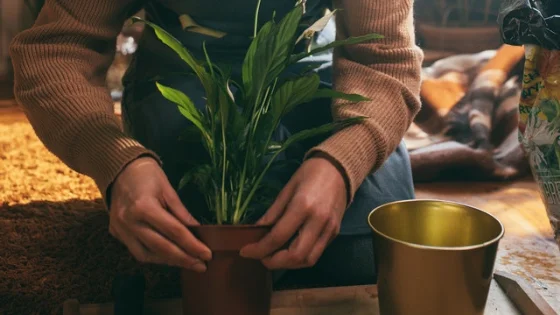Table of Contents
How to Repot a Peace Lily Plant
Peace lilies are a popular choice these days for the home or office. The Latin name for them is Spathiphyllum.
They are also known as closet plants. The plants are easy to care for and brighten up any space beautifully. Peace lilies even clean the air of the room you place them in.
Feng Shui tells us that peace lilies bring their owner good fortune. They also calm and harmonize the energy of the room they are in.
The white color means peace and purity. They can help you to develop your spirituality, so they are ideal for a meditation room.
The plants have dark green leaves and white flowers. In fact, the flower is a leaf bract that grows over the flower to protect it. These large, hooded sheaths cover a fleshy, green, or yellow flower that is like a spike.
This spike is called a spadix and gives us small flowers. These flowers are typical of plants in the Araceae family. With such tiny flowers, it’s the job of the white lily-like leaves to attract bees to the plant.
Peace lilies come in a variety of types and sizes, but the standard peace lily plant grows to about 3 feet (1 meter) high. The leaves of the peace lily are usually deep green in color, although there are variegated varieties that have dots or stripes of cream mixed in with the green.
Originally, peace lilies were tropical plants so they thrive in warm conditions and rich, fertilized soil. They would have been growing on the rainforest floor in tropical areas of the Americas or Asia.
As a result, the peace lilies received dappled sunlight filtering through the forest canopy above. Ideally, you want to recreate these conditions in your home or office space.
One of the most common mistakes in peace lily care is overwatering. They only need water when the compost feels very dry. Just feel inside the pot to tell when water is necessary.
The peace lily is happy when its roots are close together making a tight fit in the pot, but there will come a time when you will have to face repotting your peace lily.
Read on for top tips on repotting!
Does Your Peace Lily need Repotting?
It is vital to know when to repot your beloved plant to keep it at its happiest and in the best of health. It’s time for a bigger pot when your lily is root-bound.
The term root-bound means that the plant has grown too big for its container. Signs of your peace lily being root-bound are:
- Wilting
- Yellow or brown leaves
- Deformed leaves
- Stunted growth
- Cracked container
- Roots showing above the soil
- Hard to remove the plant from the pot
- Roots form a matted ball
Ideally, you should repot your plant in the spring when it is easy for the lily to feel re-energized. The milder temperatures will give your plant a boost.
Step by Step Guide to Repotting a Peace Lily
What You Need:
- Top quality potting compost mix
- One container an inch larger than the old pot
- Small 4-inch new pots for the crowns.
- A knife, secateurs, or scissors
- Gardening gloves
- Newspaper
- A stick or twig
- Garden hose
- A stiff brush
- Jeyes fluid or another type of disinfectant
- A towel
- Oil
- A length of string
- A watering can filled with water
Step 1 – Gather your materials
You need to get everything you need to hand. Look at the list above and collect everything together. The job may be easier if you perform it outside or in a potting shed. Failing that, the kitchen will suffice.
There is nothing worse than getting halfway through a job and then realizing you have forgotten something.
You will need new pots or planters that are big enough to repot the plant or smaller ones if you are dividing it. Then, you need a top-quality potting mixture. Get the best you can afford. Peace lilies like to be in moist soil but not soggy.
You need a balanced mix. If you are worried your potting compost will not retain moisture you can add choir or coco peat. Use a loamy, easy draining potting compost mixture that is high in organic matter.
A blend of peat-based potting compost that contains composted bark with sand or perlite retains water and nutrients. It also allows the plant roots to obtain plenty of oxygen.
Water your lily about an hour or two before you repot it.
Step 2 – Sterilize your equipment
You will probably need scissors or secateurs to cut the roots or trim the leaves. These items need to be sterilized to stop the spread of disease. Firstly, remove any mud from your secateurs with a stiff brush.
You might also need to wash them with a garden hose and wipe them down with a cloth. Then, apply a disinfectant such as Jeyes fluid to the blades. Leave for 20 minutes and then wipe off with a cloth.
Dry your secateurs with a towel and then oil them thoroughly. You can also disinfect your containers in the same way.
Step 3 – Bind your peace lily leaves
Take a string and tie it loosely around the leaves of your lily. The leaves are now closer to the stem. This step helps you get a grip on the plant when you are coaxing it out of its pot and stops the leaves from going everywhere.
Step 4 – Loosen the soil
Soil firms around the root of a plant to anchor it in place to stop it from moving when you water it. This compaction makes it hard to get the lily out of its container.
To avoid this difficulty, loosen the soil around the plant with a tool, a twig, or your hands. Now the soil is loose it is easy to remove the plant. Be careful not to damage your lily’s roots as you loosen the soil around it.
Step 5 – Divide the plant
Spread your newspaper around to avoid a mess. Take the lily out of the pot. Tap the sides of the container if it won’t come out easily. Now you are ready to divide it. Take a crown section away from the main plant either with your hands or with a knife.
To grow successfully, the crown needs to have at least two leaves and have roots attached. You should now have several small plants and the mother plant. Remove any loose roots and brown leaves.
Step 6 – Repotting
You will need 4-inch pots for the new plants and a larger container for the main plant. Fill the pots with your good-quality compost. For the mother plant, you will need a pot one or two inches larger than the old container.
Cover the drainage hole with mesh to stop the compost from falling out. You want the root ball to be an inch from the top of the container. Don’t bury your lily too deeply or it will cause the plant to rot.
Place the plant in the new container and fill around it with the potting mix. Firm the soil gently with your fingers.
Make sure it is at the same level as it was in the old pot. Add more compost mix if necessary. Do the same for the crowns you have separated in their own smaller pots.
Step 7 – Watering
Give all the peace lily plants a thorough watering. Let the water soak through and drain through the holes in the bottom of the pots.
Step 8 – Place Your new plant
Put the new containers in a shady area for a couple of days. There may be some wilting as the plant is shocked by its new condition but it should recover quickly.
Don’t fertilize the plant for a couple of months to let it get used to its new home.
After a few days, put your plant in its permanent place. Ideally, peace lilies need bright, indirect sunlight to bloom. Keep your lily away from drafts, as it is sensitive to cold.
General Care
Peace lilies are easy to care for. Keep an eye on them so that you can tell when they need water. Feel the top of the soil in the container. When it is very dry it’s time for watering.
Fertilize your lily two or three times throughout the spring and summer. Make sure the fertilizer you use is well diluted.
Ensure that the room temperature is kept between 65-85 °F (18-30 °C). Guard against drafts and make sure there is ample sunlight where you have placed your plant.
Finally, wash the plant with a wet cloth to keep dust away.
Enjoy your peace lily for many years to come!
Photo by KoolShooters from Pexels



